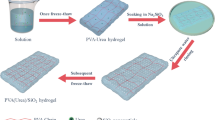Abstract
Electrospinning is one of most versatile process to fabricate porous scaffolds in biomedical field. Synthetic polymers such as polycaprolactone (PCL) and polymethyl methacrylate (PMMA) provide excellent properties for biomedical applications due to their biocompatibility and tunable mechanical properties. PCL-PMMA electrospun blends combine compressive/tensile properties of individual polymers as well as biocompatibility/biodegradability. Together with porosity of scaffold, drug/nutrient supply is required in tissue regeneration and healing. High pressure CO2 has been investigated to plasticize many biopolymers and impregnate drugs in scaffolds. This study explores several compositions of PCL-PMMA electrospun scaffolds for morphological and mechanical properties. These scaffolds are impregnated with hydrophilic (Rhodamine B) and hydrophobic (Fluorescein) dyes using high pressure CO2 and air plasma treatment. Furthermore, release profiles of dyes have been studied from thin films and porous scaffolds to understand several controlling factors for controlled release applications. Results show dye-polymer interactions, CO2 impregnation and stress relaxation of electrospun fibers are key factors in release profile from electrospun fibers. This study is a step forward in developing PCL-PMMA based electrospun scaffolds for drug delivery and tissue engineering.
Similar content being viewed by others
References
S. Fredenberg, M. Wahlgren, M. Reslow, and A. Axelsson, Int. J. Pharm. 415 (1), 34 (2011).
L. Plapied, N. Duhem, A. des Rieux, and V. Préat, Curr. Opin. Colloid Interface Sci. 16 (3), 228 (2011).
M. R. Prausnitz, P. M. Elias, T. J. Franz, M. Schmuth, J. C. Tsai, G. K. Menon, and K. R. Feingold, “Skin Barrier and Transdermal Drug Delivery,” in Dermatology, 3rd ed., Ed. by J. Bolognia, J. Jorizzo, and J. Schaffer (Elsevier Saunders, Philadelphia, PA, 2012), pp. 2065–2074.
H. Naderi, M. M. Matin, and A. R. Bahrami, J. Biomater. Appl. 26 (4), 383 (2011).
L. S. Nair, and C. T. Laurencin, “Polymers as Biomaterials for Tissue Engineering and Controlled Drug Delivery,” in Tissue Engineering I, Ed. by {K. Lee and D. Kaplan} (Springer, Berlin; Heidelberg, 2006), pp. 47–90.
R. Ravichandran, S. Sundarrajan, J. R. Venugopal, S. Mukherjee, and S.Ramakrishna, Macromol. Biosci. 12 (3), 286 (2012).
T. J. Sill and H. A. von Recum, Biomaterials 29 (13), 1989 (2008).
M. Rønbeck, A. Behndig, M. Taube, A. Koivula, and M. Kugelberg, Acta Ophthalmol. 91 (1), 66 (2013).
J. Krebs, S. J. Ferguson, B. G. Goss, E. Stauffer, L. Ettinger, and N. Aebli, J. Biomed. Mater. Res., Part B 100 (3), 660 (2012).
Y. Liu, Y. Ji, K. Ghosh, R. A. Clark, L. Huang, and M. H. Rafailovich, J. Biomed. Mater. Res., Part A 90 (4), 1092 (2009).
H. Becker and L. E. Locascio, Talanta 56 (2), 267 (2002).
T. K. Dash and V. B. Konkimalla, J. Controlled Release 158 (1), 15 (2012).
J. Gunn and M. Zhang, Trends Biotechnol. 28 (4), 189 (2010).
A. Sionkowska, Prog. Polym. Sci. 36 (9), 1254 (2011).
S. H. Hsu and W. C. Chen, Biomaterials 21 (4), 359 (2000).
B. J. Park, H. J. Seo, J. Kim, H. L. Kim, J. K. Kim, J. B. Choi, I. Han, S. O. Hyun, K.-H. Chung, and J. C. Park, Surf. Coat. Technol. 205, S222–S226 (2010).
U. Hersel, C. Dahmen, and H. Kessler, Biomaterials 24 (24), 4385 (2003).
R. Srikar, A. L. Yarin, C. M. Megaridis, A. V. Bazilevsky, and E. Kelley, Langmuir 24 (3), 965 (2008).
S. Yoda, K. Sato, and H. T. Oyama, RSC Adv. 1 (1), 156 (2011).
H. B. Hopfenberg, L. Nicolais, and E. Drioli, Polymer 17 (3), 195 (1976).
R. G. Matthews, A. Ajji, M. M. Dumoulin, and R. E. Prud’homme, Polymer 41 (19), 7139 (2000).
A. V. Tobolsky, J. Appl. Phys. 27(7), 673 (2004).
L. N. Ludueña, V. A. Alvarez, and A. Vazquez, J. Mater. Sci. Eng. A 460, 121 (2007).
H. Eslami, M. Kesik, H. A. Karimi-Varzaneh, and F. Müller-Plathe, J. Chem. Phys. 139 (12), 124902 (2013).
P. L. Ritger and N. A. Peppas, J. Controlled Release 5 (1), 37 (1987).
Author information
Authors and Affiliations
Corresponding author
Additional information
The article is published in the original.
Rights and permissions
About this article
Cite this article
Munj, H.R., Tomasko, D.L. Polycaprolactone-polymethyl methacrylate electrospun blends for biomedical applications. Polym. Sci. Ser. A 59, 695–707 (2017). https://doi.org/10.1134/S0965545X17050121
Received:
Revised:
Published:
Issue Date:
DOI: https://doi.org/10.1134/S0965545X17050121




